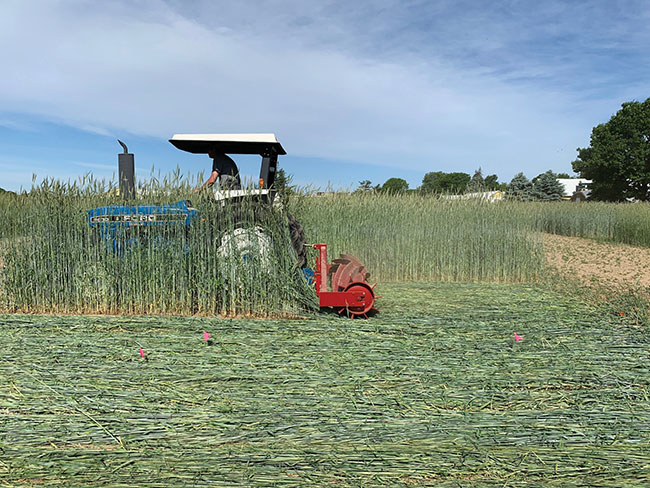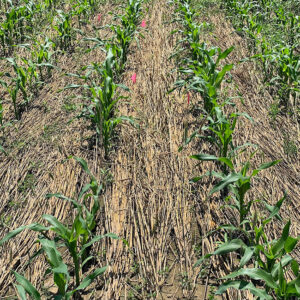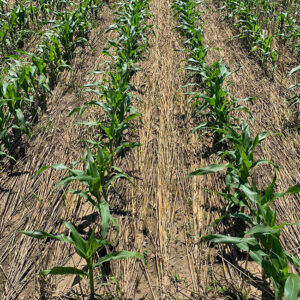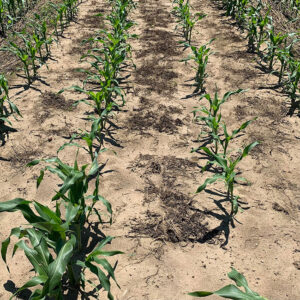
Features
Cover Crops
Weed Management
Suppressing weeds with covers in sweet corn
Roller crimping is popular in the U.S. Can it take off in Ontario?
March 13, 2023 By Julienne Isaacs
 Roller crimping of cereal rye performed by Jeff
McCormick, farm foreman at the AAFC Harrow Research and Development Centre.
All photos courtesy of Hayley Brackenridge.
Roller crimping of cereal rye performed by Jeff
McCormick, farm foreman at the AAFC Harrow Research and Development Centre.
All photos courtesy of Hayley Brackenridge. Roller-crimping a fall-sown cereal rye cover crop is a popular practice in some parts of the United States: it’s an effective weed suppressant and it saves a herbicide application.
But it’s not as popular in Canada, says Hayley Brackenridge, an organic research specialist for Agriculture and Agri-Food Canada (AAFC).
This is partly because research on roller crimping as a weed-control strategy is lacking north of the border, Brackenridge says. Producers are understandably leery about investing in new equipment without assurance it’ll pay off. There are alternatives to buying tractor-pulled or mounted roller crimpers outright, though.
“There’s a barrier to adoption because you have to invest in the equipment, but some producers who have bought it are looking at loaning or cost-sharing it,” she says. “Companies that bring it into [Canada to] sell are doing demonstrations for producers to test it before they buy it.”
When it comes to research, the data is slowly rolling in. In 2022, Brackenridge published her master’s thesis at the University of Guelph on management practices for producers aiming to use roller-crimped fall rye as a weed suppressant in sweet corn, co-supervised by Francois Tardif, a professor in the department of plant science at the University of Guelph, and Robert Nurse, an AAFC research scientist.
As part of the study, Brackenridge conducted two trials. One looked at three seeding rates for two rye cultivars, one standard and one early maturing. The second evaluated rye planting directions (north-south versus east-west) and roller crimping directions.
Brackenridge says she opted to focus her work on sweet corn due to the crop’s popularity in Ontario, and because it can be sown late without sacrificing profitability.
Study design and results
The study took place between 2019 and 2021 at three AAFC sites across the country: Agassiz, B.C.; Harrow, Ont.; and St. Jean-sur-Richelieu, Que., although each year the trials took place in different fields within each location.
In each location, a local standard rye variety was compared to Elbon, a southern U.S.-developed winter cereal rye, at three seeding rates: 150, 300, and 600 seeds per square metre (seeds/m2). There were also weedy and weed-free no-rye control plots.
Brackenridge also opted to compare treatments with and without post-emergent herbicide applications.
Rye cover crops were terminated via roller crimping when plants reached a stage between 50 per cent anthesis and early milk stage. Brackenridge opted to use three-metre-wide rear tractor-mounted roller crimpers filled with water. Six days following termination, corn was planted with no-till planters directly into the crimped rye.
Brackenridge says seeding rates between 300 and 600 seeds/m2 seemed to be most effective in terms of weed control.
“The increase in weed control by mid and high seeding rates may be attributed to their higher biomass and ground coverage compared to the low seeding rate,” she writes in her thesis. “Increased cover crop biomass has been shown to increase ground coverage, which improves weed control.”
Interestingly, weed control improved with seeding rates between 300 and 600 seeds/m2, Brackenridge notes, but there was no statistical difference between the mid and high rate. In other words, producers can assume that 300 seeds/m2 is adequate.
“Three hundred [seeds per square metre] is based on the typical rate that people would sow rye as a cover crop,” she says. “[It was] good to see that result, that [the highest rate is] not necessarily required, because that will save producers a lot of money.”
Recommendations and next steps
Although there was a positive correlation between mid and high seeding rates and weed control, neither rate – 300 or 600 – provided enough weed control to prevent yield loss in sweet corn.
Even so, Brackenridge says there are still appreciable benefits to the system.
“Future research should test the feasibility of applying post-emergent herbicides to control weeds after roller crimping,” Brackenridge concludes her thesis. “Combining roller-crimped rye with post-emergent herbicide could create an effective integrated weed management program that reduces chemical inputs and builds soil health and stability.”
One experiment, where roller-crimped rye was combined with a post-emergent herbicide, performed really well, she says.
This means producers could potentially eliminate use of a pre-emergent herbicide and start to reduce reliance on chemical inputs.
“It doesn’t produce completely clean, high yields on its own, but having a combination is beneficial,” says Brackenridge. “It reiterates the value of integrated pest management – you can’t rely on one system exclusively. It’s combining multiple systems that will give us the best results.”
In terms of varietal differences, Brackenridge notes use of the earlier-maturing variety Elbon offered no benefit to weed control or yield, partly because local standard varieties provided higher biomass.


